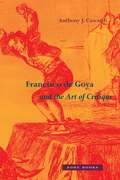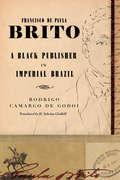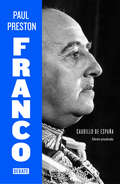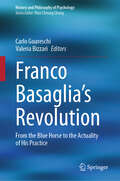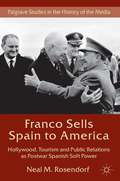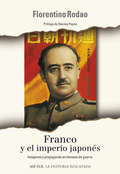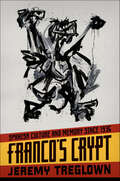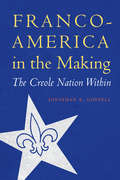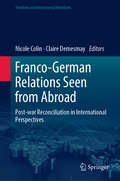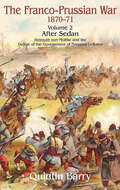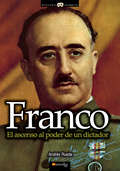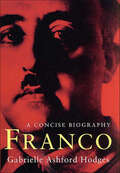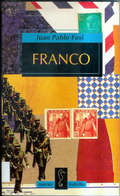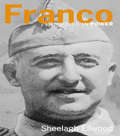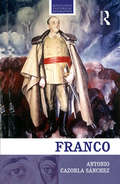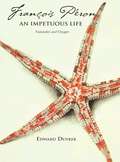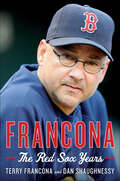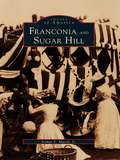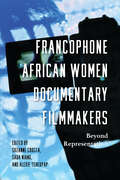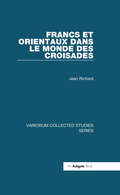- Table View
- List View
Francisco de Goya and the Art of Critique
by Anthony J. CascardiAn innovative study of Goya's unprecedented elaboration of the critical function of the work of artFrancisco de Goya and the Art of Critique probes the relationship between the enormous, extraordinary, and sometimes baffling body of Goya’s work and the interconnected issues of modernity, Enlightenment, and critique. Taking exception to conventional views that rely mainly on Goya’s darkest images to establish his relevance for modernity, Cascardi argues that the entirety of Goya’s work is engaged in a thoroughgoing critique of the modern social and historical worlds, of which it nonetheless remains an integral part. The book reckons with the apparent gulf assumed to divide the Disasters of War and the so-called Black Paintings from Goya’s scenes of bourgeois life or from the well-mannered portraits of aristocrats, military men, and intellectuals. It shows how these apparent contradictions offer us a gateway into Goya’s critical practice vis-à-vis a European modernity typically associated with the Enlightenment values dominant in France, England, and Germany. In demonstrating Goya’s commitment to the project of critique, Cascardi provides an alternative to established readings of Goya’s work, which generally acknowledge the explicit social criticism evident in works such as the Caprichos but which have little to say about those works that do not openly take up social or political themes. In Francisco de Goya and the Art of Critique, Cascardi shows how Goya was consistently engaged in a critical response to—and not just a representation of—the many different factors that are often invoked to explain his work, including history, politics, popular culture, religion, and the history of art itself.
Francisco de Paula Brito: A Black Publisher in Imperial Brazil
by Rodrigo Camargo GodoiFrancisco de Paula Brito is a biography of a merchant, printer, bookseller, and publisher who lived in Rio de Janeiro from his birth in 1809 until his death in 1861. That period was key to the history of Brazil, because it coincided with the relocation of the Portuguese Court from Lisbon to Rio de Janeiro (1808); the dawning of Brazilian Independence (1822) and the formation of the nation-state; the development of the press and of Brazilian literature; the expansion and elimination of the trans-Atlantic slave trade; and the growth of Rio de Janeiro&’s population and the coffee economy. Nevertheless, although it covers five generations of Paula Brito&’s family—men and women who left slavery in the eighteenth century—this book focuses on its protagonist&’s activities between the 1830s and 1850s. During that period, Francisco de Paula Brito became one of the central figures in the cultural and political scene in the Imperial capital, particularly through his work as a publisher. Paula Brito&’s success was due in part to his ability to forge solid alliances with the Empire&’s ruling elite—among them leading politicians responsible for the unification of the vast Brazilian territory and for the maintenance of slavery and the illegal trafficking of Africans. Consequently, through the books and newspapers he published, Francisco de Paula Brito became part of a much larger project.
Franco (edición actualizada): Caudillo de España
by Paul PrestonLa publicación de esta edición revisada y actualizada de la biografía de Franco de Paul Preston, a los cuarenta años de la muerte del dictador, es un acontecimiento, no en vano sigue siendo considerada unánimemente como la obra de referencia. Contra la visión de Franco como figura providencial, una biografía completísima, rigurosa y apasionante del hombre que rigió España durante tantos años, donde se muestra al militar ambicioso e implacable, al admirador de Hitler y Mussolini; al dirigente político cada vez más pagado de su propio papel, pero incapaz de comprender la complejidad de Estado y la economía modernas. Queda el hombre visceralmente conservador, tan cauto como ambicioso, hábil en el manejo de las personas y de los contrapesos del poder. Un libro imprescindible para quien quiera comprender la historia reciente de España, así como a uno de los personajes centrales de la misma. La crítica ha dicho...«Paul Preston ha escrito, y con gran diferencia, la mejor biografía del dictador Franco.»L.M. Anson «La biografía definitiva y apasionante del dictador español Francisco Franco.»Publishers Weekly «Preston nos presenta un retrato de Franco muy diferente al que generalmente conocemos.»Kirkus Review
Franco Basaglia's Revolution: From the Blue Horse to the Actuality of His Practice (History and Philosophy of Psychology)
by Carlo Guareschi Valeria BizzariThis book explores the importance of the work of Franco Basaglia, a pioneer in the democratic psychiatry movement. Using a multidisciplinary approach combining philosophy and psychology this volume seeks to illuminate the past and create a clearer picture of Basaglia's impact in conceptualizing modern psychiatric care. It reviews the contemporary status of care and offers new insights for a critical evaluation of care that takes the psychiatric revolution to a new level. Highlights Basaglia’s diagnostic and clinical practice Employs a multi-disciplinary approach Joins phenomenology and critical theory
Franco Modigliani and Keynesian Economics: Theory, Facts and Policy (Perspectives in Economic and Social History)
by Antonella RancanThis book follows the intellectual path of Franco Modigliani, Nobel Prize winner and one of the most influential Keynesian economists of the twentieth century, tracing his development and examining the impact of his research. The book begins with Modigliani’s early work as a young law student in 1930s Italy and traces his development through his emigration to the US, his introduction to Keynes’ General Theory at the New School, and his seminal 1944 article on Keynesian and classical economics. The book also examines Modigliani’s pioneering theory of savings: the life-cycle hypothesis (with Richard Brumberg), and the Modigliani–Miller theorem, a cornerstone of modern theory of finance. The book argues that although Modigliani is placed amongst the most prominent Keynesian economists, his connections with Keynesian theory are of secondary importance until the beginning of the 1960s when he joined MIT. This is the first book to place Modigliani’s thought in its proper historical context, showing how it related to wider economic concerns and examining the social and political implications of his work. It will be of interest to scholars in the history of economic thought, and especially post-war American Keynesian economics.
Franco Sells Spain to America
by Neal M. RosendorfA groundbreaking study of the Franco regime's utilization of Hollywood film production in Spain, American tourism, and sophisticated public relations programs - including the most popular national pavilion at the 1964-65 New York World's Fair - in a determined effort to remake the Spanish dictatorship's post-World War II reputation in the US.
Franco and the Spanish Civil War
by Filipe Ribeiro De MenesesFranco and the Spanish Civil War is a wide-ranging and insightful analysis of the origins, course, and consequences of the conflict and of Franco's role within it. It offers a broad view of the war through a survey of the social and cultural dimensions, as well as the military and political ones. In particular, it traces Franco's meteoric rise to power, his conduct in the war, and his long subsequent rule. This authoritative introduction illuminates the many different interpretations of the conflict by examining a variety of perspectives. Franco and the Spanish Civil War places the war in its national and global contexts, exploring both nationalist and republican points of view, and giving attention to foreign participation in the conflict.
Franco y el Imperio Japonés
by Florentino Rodao GarcíaInsólito estudio sobre la relaciones entre España y Japón durante la Segunda Guerra Mundial. El interés que la historiografía ha mostrado hacia las relaciones de la España franquista con la Alemania nazi y la Italia fascista ha provocado que se olvidaran las existentes con el régimen japonés, que también formaba parte del Eje. Y tales relaciones, a pesar de la lejanía y las dificultades de comunicación, tenían que ser relevantes en la estrategia de Japón que, ya enfrascado en una guerra de conquista en China, había abierto nuevos frentes de batalla en el sudeste asiático y el Pacífico en el marco de la Segunda Guerra Mundial. Las posibilidades de cooperación entre ambos regímenes tuvieran nuevas dimensiones con la expansión continental de los años 1940-41 y, posteriormente, con las actividades que asumió Madrid por cuenta de Tokio después de Pearl Harbor: el espionaje y la protección de las numerosas colonias de emigrantes japoneses en elcontinente americano, las más importantes que realizó un país neutral. El distanciamiento español de Japón cuando terminó el ciclo de victorias militares del imperio -Franco incluso llegó a especular con una declaración de guerra en marzo de 1945, que rechazaron los aliados- sirvió de ensayo al régimen para la previsible ruptura con Alemania e Italia y el acercamiento a los Aliados. La característica fundamental de los contactos es que, a diferencia de los que mantenía el régimen con Alemania e Italia, nunca se desarrollaron bajo el signo de la afinidad cultural e ideológica, sino sólo como alianza utilitaria. Por eso para Franco -que creía que la derrota de Japón era consecuencia de la incapacidad de los orientales para acceder a la civilización- la ruptura no fue difícil.
Franco's Crypt: Spanish Culture and Memory Since 1936
by Jeremy TreglownAn open-minded and clear-eyed reexamination of the cultural artifacts of Franco's SpainTrue, false, or both?Spain's 1939-75 dictator, Francisco Franco, was a pioneer of water conservation and sustainable energy.Pedro Almodóvar is only the most recent in a line of great antiestablishment film directors who have worked continuously in Spain since the 1930s.As early as 1943, former Republicans and Nationalists were collaborating in Spain to promote the visual arts, irrespective of the artists' political views.Censorship can benefit literature.Memory is not the same thing as history.Inside Spain as well as outside, many believe-wrongly-that under Franco's fascist dictatorship, nothing truthful or imaginatively worthwhile could be said or written or shown. In his groundbreaking new book, Franco's Crypt: Spanish Culture and Memory Since 1936, Jeremy Treglown argues that oversimplifications like these of a complicated, ambiguous actuality have contributed to a separate falsehood: that there was and continues to be a national pact to forget the evils for which Franco's side (and, according to this version, his side alone) was responsible.The myth that truthfulness was impossible inside Franco's Spain may explain why foreign narratives (For Whom the Bell Tolls, Homage to Catalonia) have seemed more credible than Spanish ones. Yet La Guerra de España was, as its Spanish name asserts, Spain's own war, and in recent years the country has begun to make a more public attempt to "reclaim" its modern history of fascism. How it is doing so, and the role played in the process by notions of historical memory, are among the subjects of this wide-ranging and challenging book.Franco's Crypt reveals that despite state censorship, events of the time were vividly recorded. Treglown looks at what's actually there-monuments, paintings, public works, novels, movies, video games-and considers, in a captivating narrative, the totality of what it shows. The result is a much-needed reexamination of a history we only thought we knew.
Franco-America in the Making: The Creole Nation Within (France Overseas: Studies in Empire and Decolonization)
by Jonathan K. GosnellEvery June the city of Lowell, Massachusetts, celebrates Franco-American Day, raising the Franco-American flag and hosting events designed to commemorate French culture in the Americas. Though there are twenty million French speakers and people of French or francophone descent in North America, making them the fifth-largest ethnic group in the United States, their cultural legacy has remained nearly invisible. Events like Franco-American Day, however, attest to French ethnic permanence on the American topography. In Franco-America in the Making, Jonathan K. Gosnell examines the manifestation and persistence of hybrid Franco-American literary, musical, culinary, and media cultures in North America, especially New England and southern Louisiana. To shed light on the French cultural legacy in North America long after the formal end of the French empire in the mid-eighteenth century, Gosnell seeks out hidden French or “Franco” identities and sites of memory in the United States and Canada that quietly proclaim an intercontinental French presence, examining institutions of higher learning, literature, folklore, newspapers, women’s organizations, and churches. This study situates Franco-American cultures within the new and evolving field of postcolonial Francophone studies by exploring the story of the peoples and ideas contributing to the evolution and articulation of a Franco-American cultural identity in the New World. Gosnell asks what it means to be French, not simply in America but of America.
Franco-German Relations Seen from Abroad: Post-war Reconciliation in International Perspectives (Frontiers in International Relations)
by Nicole Colin Claire DemesmayThis book examines external perceptions of the Franco-German relationship, both from a historical perspective and as a driving force for regional integration. By providing various country and regional studies, it analyses the various types of perception and self-perception in several regions around the globe. Here, Franco-German cooperation serves as a mirror in which third-party countries view their own situation, today and in the future. The contributions address the questions of if and how the Franco-German reconciliation and cooperation is perceived as a role model for other regions, especially for the reconciliation of other inter-state and international conflicts. A concluding chapter highlights the divergences and convergences between the respective conflicts, and proposes recommendations for actors involved in diplomacy and international relations.The book is intended to provide scientific support for the implementation of the Franco-German Aachen Treaty of January 2019. It will appeal to scholars in political science and cultural studies, and to anyone interested in learning more about the Franco-German relationship and on external perspectives on it.
Franco-Israeli Relations, 1958-1967 (Routledge Studies in Modern European History)
by Gadi HeimannSince the Sinai campaign, France had been Israel's ally, providing advanced weapons and granting political support and economic aid. When Charles de Gaulle returned to lead France in 1958 during the Algerian War, Israeli leadership faced a challenge to maintain the friendship in light of the President's insistence on re-establishing French influence in the Arab world. This book discusses their efforts and examines de Gaulle's uncompromising pursuit of French grandeur and the ramifications of this for the State of Israel.
Franco-Prussian War 1870–1871, Volume 1: The Campaign of Sedan: Helmuth Von Moltke and the Overthrow of the Second Empire (Franco-prussian War 1870-1871 Volume 1: The Campaign Of Sedan Ser. #1)
by Quintin BarryThe first volume of this comprehensive study of the Franco-Prussian War presents a detailed account of Germany Confederation&’s decisive victory over France. In the first part of this two-volume military history, Quintin Barry examines the war against the French Imperial Army waged by the armies of the German Confederation, directed by that supreme military mind, Helmuth von Moltke. Barry places Moltke and his strategic planning in the context of the European balance of power following the ending of the Austria Prussian War in 1866. He then explores the initial mobilization and deployment of the armies in 1870. All the battles of this opening round of the war are described in detail, including Weissenburg, Worth, Spicheren, Borny-Colombey, Mars la Tour, Gravelotte, Beaumont and, of course, Sedan. The book ends as the Second Empire of Napoleon III lies defeated, crushed by the German armies. Barry has made full use of an extensive number of German and French language sources. His detailed text is accompanied by a number of black and white illustrations and newly drawn battle maps. Orders of battle are also provided.
Franco-Prussian War 1870–1871, Volume 2: After Sedan: Helmuth Von Moltke and the Defeat of the Government of National Defence (Franco-prussian War 1870-1871 Volume 2: After Sedan Ser. #2)
by Quintin BarryThe second volume of this comprehensive military history examines the fall of the Second French Empire and the founding of a unified Germany.Helmuth von Moltke&’s victory over France in the Battle of Sedan resulted in the capture of Napoleon III. But the war against the Government of National Defense presented quite different problems to von Moltke and his staff.Although the Siege of Paris loomed large during the second phase of the war, historian Quintin Barry fully explores events in other parts of France, including the siege of Strasbourg, the activities of the Francs Tireurs, the investment of Metz, and the battle against the French armies of the Loire, the North, and the East. As with the first volume of this study, Barry has made full use of an extensive number of German and French language sources. His detailed text is accompanied by a number of black and white illustrations and newly drawn battle maps. Orders of battle are also provided.
Franco. El ascenso al poder de un dictador (Historia Incógnita)
by Andrés RuedaUna novedosa biografía de Francisco Franco basada en una rigurosa investigación histórica apoyada en una espectacular cantidad de material gráfico. Conozca en detalle todos los episodios clave de su carrera militar, del alzamiento y de la Guerra Civil, que le condujeron a convertirse en el Caudillo. Descubra también la faceta más humana de un dictador atormentado, inseguro y oportunista, que gracias a su astucia y personalidad llegó a convertirse en la figura más determinante de la historia de España durante el siglo XX Esta obra, finalista del premio Espejo de España, es una novedosa aproximación a la figura de Francisco Franco desde dentro. El psiquiatra Andrés Rueda se adentra en la biografía del dictador para rebuscar los episodios clave de su vida, las consecuencias que tuvieron en la forma de actuar y pensar de Franco, y cómo repercutieron esos traumas en la historia de España. Una investigación histórica y psicológica apoyada con una espectacular cantidad de material gráfico, que incluyen fotografías desconocidas, donde Andrés Rueda analiza los hechos, sus discursos, sus conversaciones, sus reacciones para trazar un perfil de este dictador con la máxima precisión y rigor y huyendo de los revisionismos interesados. Gracias a esta obra sin parangón, Franco, por primera vez, aparece en su faceta más humana, alejada de las brillantes distorsiones propagandísticas que rodearon su figura, en un intento, no de justificación, si no de explicación de por qué Franco se convirtió en la figura más determinante en la historia de España durante el siglo XX. A través de las páginas de esta obra, el lector descubrirá a un Franco acomplejado y atormentado, lleno de razones y sinrazones, inseguro y oportunista, un hombre mediocre y vulgar, que llegó a dirigir el destino de todo un país durante más de cuarenta años. Argumentos de venta - Se trata de la primera biografía de Franco que combina la historia rigurosa de su carrera y hechos militares, el análisis brillante de su compleja y atormentada personalidad y su ambición de dictador. - El título está repleto de citas bibliográficas, información inédita de diversas fuentes, prensa de la época... que documentan los hechos narrados dotándolos de rigor histórico. - Rueda presenta documentación y tésis inéditas sobre Franco, como la dudosa paternidad de su hija Carmen, la clave criptográfica usada en la comunicación del alzamiento o la foto de Franco sin bigote. - Franco permite entender de modo claro las razones y hechos que llevaron a un joven e inexperto general a autoproclamarse caudillo de España
Franco: A Concise Biography
by Gabrielle Ashford HodgesGeneral Francisco Franco came to prominence during the days of David Lloyd George and Woodrow Wilson and was able to cling to absolute political power until his death in 1975. Over his fifty-year career, he became one of the four dictators who changed the face of Europe during the twentieth century.Franco joined the Spanish Army when he was barely fifteen years old. In 1926 he became the youngest general in Europe and, driven by an astonishing sense of his own greatness, was recognized as sole military commander of the Nationalist zone during the Spanish Civil War. His ambition was always to hold on to the power that he had secured. In practice, this meant winning the Spanish Civil War and surviving the fall of the fascist regimes of Hitler and Mussolini and the international isolation that followed their defeat.But behind the military heroics and dexterous political footwork lay an insecure and vengeful man, wracked by contradictory impulses. Although fueled by a single-minded determination to succeed, he was full of self-doubt. A bold and sometimes inspirational soldier in Africa, he became an indecisive, hesitant military commander during the Civil War. Filled with a burning conviction that his destiny was bound up with the medieval kings of Spain and God Himself, he appeared shy, withdrawn, and humble. Ruthlessly intent on wiping out all political opposition, he denied heatedly that he was a dictator. A stubborn man, he could be remarkably flexible when it came to safeguarding his power.Gabrielle Ashford Hodges' psychological biography considers Franco's mental state, as well as his political motivation. In doing so, it succeeds admirably in getting under the skin of Europe's most enduring dictator.
Franco: Autoritarismo y poder personal (Punto De Lectura Ser. #Vol. 128)
by Juan Pablo FusiFranco. Autoritarismo y poder personal no es solo una de las más equilibradas biografías del personaje, sino una estupenda síntesis de lo que fueron cuarenta años decisivos en la historia de España. Juan Pablo Fusi despliega en este libro el doble mérito de haberse acercado a la figura de Franco con el rigor del historiador exigente, y el de haber sabido aproximarlo a sus lectores con el estilo de un relato apasionante.
Franco: Falange Espanola De Las Jons, 1936 76 (Profiles In Power)
by Sheelagh M. EllwoodAn excellent introduction to Franco's rise to power and his four decades as autocratic head of state in Spain.
Franco: The Biography of the Myth (Routledge Historical Biographies)
by Antonio Cazorla-SanchezGeneral Francisco Franco, also called the Caudillo, was the dictator of Spain from 1939 until his death in 1975. His life has been examined in many previous biographies. However, most of these have been traditional, linear biographies that focus on Franco’s military and political careers, neglecting the significance of who exactly Franco was for the millions of Spaniards over whom he ruled for almost forty years. In this new biography Antonio Cazorla-Sanchez looks at Franco from a fresh perspective, emphasizing the cultural and social over the political. Cazorla-Sanchez's Franco uses previously unknown archival sources to analyse how the dictator was portrayed by the propaganda machine, how the opposition tried to undermine his prestige, and what kind of opinions, rumours and myths people formed of him, and how all these changed over time. The author argues that the collective construction of Franco’s image emerged from a context of material needs, the political traumas caused by the Spanish Civil War (1936-1939), the complex cultural workings of a society in distress, political manipulation, and the lack of any meaningful public debate. Cazorla-Sanchez's Franco is a study of Franco’s life as experienced and understood by ordinary people; by those who loved or admired him, by those who hated or disliked him, and more generally, by those who had no option but to accommodate their existence to his rule. The book has a significance that goes well beyond Spain, as Cazorla-Sanchez explores the all-too-common experience of what it is like to live under the deep shadow cast by an always officially praised, ever present, and long lasting dictator.
Francois Ozon (Contemporary Film Directors)
by Thibaut SchiltIn just over a decade, François Ozon has earned an international reputation as a successful and provocative filmmaker. A student of Eric Rohmer and Jean Douchet at the prestigious Fémis, Ozon made a number of critically acclaimed shorts in the 1990s and released his first feature film Sitcom in 1998. Two additional shorts and eleven feature films have followed, including international successes 8 femmes and Swimming Pool and more recent releases such as Angel, Ricky, and Le refuge. Ozon's originality lies in his filmmaking style, which draws on familiar cinematic traditions (the crime thriller, the musical, the psychological drama, the comedy, the period piece) but simultaneously mixes these recognizable genres and renders them unfamiliar. Despite tremendous diversity in cinematic choices, Ozon's oeuvre is surprisingly consistent in its desire to blur the traditional frontiers between the masculine and the feminine, gay and straight, reality and fantasy, auteur and commercial cinema. Thibaut Schilt provides an overview of François Ozon's career to date, highlighting the director's unrestrained, voracious cinephilia, his recurrent collaborations with women screenwriters and actresses, and the trademarks of his cinema including music, dance, and the clothes that accompany these now typically Ozonian episodes. Schilt contextualizes Ozon's filmmaking within the larger fields of French filmmaking and international queer cinema, and he discusses several major themes running through Ozon's work, including obsessions with inadequate fathers, various types of mourning, and a recurring taste for "the foreign." The volume also includes an insightful interview with the director.
Francois Peron: An Impetuous Life
by Edward DuykerIn 1800 François Péron, an ambitious young medical student not long released from the French revolutionary army, gained a place as an assistant zoologist on Nicolas Baudin's expedition to Australian waters. As his colleagues either deserted or died, he would rise rapidly within the expedition's ranks and even write its official account. In doing so, Péron would seek to destroy Baudin's posthumous reputation. The expedition was famously marked by the vexed relationship between Péron and Baudin, but Péron's work, as a man of science, profoundly enhanced the achievements of the expedition: he seized valuable opportunities to pioneer zoological, oceanographic and ethnographic studies, and as an ecological observer was remarkably prescient. Edward Duyker's meticulously researched biography of Péron takes readers on an engaging and wide-ranging journey—from the heart of pre-revolutionary rural France, to the bitter fighting on the Rhineland front in 1793-94, to the late eighteenth-century Paris medical school, to landfalls in the Atlantic and the Indian Oceans, to the little-known shores of Van Diemen's Land and New Holland, and back into the very heart of Napoleon's Empire. This is both a balanced assessment of the difficult relationship between Péron and Baudin, and an analysis of the conduct of science during some of the most turbulent years in French history.
Francona: The Red Sox Years
by Dan Shaughnessy Terry FranconaTHE NEW YORK TIMES BESTSELLER. “Eloquent and dazzling,” the story of the legendary baseball manager’s tenure with the Boston Red Sox (Philadelphia Daily News).When Terry Francona took over as manager of the Boston Red Sox in 2004, the storied franchise hadn’t won a World Series championship in eighty-six years. Led by Francona, the team won two over the course of four years. During the full eight years of Francona’s tenure, the Red Sox were transformed from “cursed” into one of the most successful and profitable teams in baseball history—only to fall back to last place as soon as Francona was gone.Francona: The Red SoxYears lets readers in on the inner workings of the Red Sox clubhouse like no book has ever done before. From the highs of the World Series to the lows of the final months of the 2011 season—the most epic collapse of a team in baseball history—this book features the never-before-told stories about Sox fans’ favorite players, moments, wins, and losses.“A scorched-earth memoir . . . [that] touches fleetingly on steroid use, sabermetrics, and Michael Jordan’s stint in the minor leagues . . . but saves its heaviest artillery for the owners . . . [and] Theo Epstein backs him up.” —The New York Times Book Review“It’s not often that baseball aficionados and gossip gluttons can plunk down on a shared portion of outfield grass with the same book for an afternoon of readerly delight, but Francona can bridge those kinds of differences.” —The Boston Globe
Franconia and Sugar Hill (Images of America)
by Arthur F. March Jr.Although geographically contiguous and linked by their shared industries of early iron works and latertourism, Franconia and Sugar Hill are unique areas with distinct personalities that have developed over the years. The discovery of rich deposits of iron ore in Sugar Hill in the late 1700s and the establishment of iron works in Franconia brought the two areas together in a working partnership. The coming of the railroads brought tourism into both communities, with Franconia supplying the scenery with its mountains and far-famed Franconia Notch, and Sugar Hill rounding out the scenery with a generous offering of grand summer hotels. The sharing of the summer tourist industry was greatlybroadened by the development of skiing in the early part of the present century. Again, Franconia provided the major terrain and Sugar Hill provided many of the guest accommodations, including the first formal ski school at the prestigious Peckett's Inn. With all of its attributes, the area has attracted a number of notables, including movie star Bette Davis.
Francophone African Women Documentary Filmmakers: Beyond Representation (Studies in the Cinema of the Black Diaspora)
by Florence Martin Melissa Thackway Sheila Petty El Hadji Diop Felix Veilleux Suzanne Gauch Herve TchumkamFrancophone African Women Documentary Filmmakers is groundbreaking edited collection which explores the contributions of Francophone African women to the field of documentary filmmaking. Rich in its scope and critical vision it constitutes a timely contribution to cutting-edge scholarly debates on African cinemas. Featuring 10 chapters from prominent film scholars, it explores the distinctive documentary work and contributions of Francophone African women filmmakers since the 1960s. It focuses documentaries by North African and Sub-Saharan women filmmakers, including the pioneering work of Safi Faye in Kaddu Beykat, Rama Thiaw's The Revolution Will Not be Televised, Katy Lena Ndiaye's Le Cercle des noyes and En attendant les hommes, Dalila Ennadre's Fama: Heroism Without Glory and Leila Kitani's Nos lieux interdits. Shunned from costly fictional- 35mm-filmmaking, Francophone African Women Documentary Filmmakers examines how these women engaged and experimented with documentary filmmaking in personal, evocative ways that countered the officially sanctioned, nationalist practice of show and teach/promote.
Francs et Orientaux dans le monde des croisades (Variorum Collected Studies)
by Jean RichardThis latest volume by Jean Richard is concerned with the evolution of the crusading movement and with the interaction between crusaders and indigenous peoples of the Near East. The articles look at changes in the concept of crusading, means of financing it, and forms of indulgence; at how the adoption of maritime transport created a need to control the sea, and how contacts with the Muslims could lead to peaceful means of resolving conflict and dealing with prisoners. In their lands in the east, the Latins accommodated the feudal structures they brought with them to local conditions, especially in the mountains. Both in this and in the religious sphere compromises were made, and in this co-existence each community preserved its individuality. The final section then considers roles played by eastern Christians in the contacts between Europeans and Mongols. Si les origines de la croisade retiennent l'attention, son évolution mérite elle aussi intérêt. La conception de la croisade, les modalités du financement, la forme d'indulgence, se sont modifiées; l'adoption du transport par bateau a nécessité la prise du contrôle de la mer. Les affrontements avec les Musulmans ont provoqueé des contacts, ainsi pour règler le sort des prisonniers; on a cheché des solutions pacifiques au conflit. Dans leurs possessions orientales, les Francs ont adapté le régime seigneurial aux conditions locales et, tout en gardant intacte leur structure féodale, réservé, surtout dans les montagnes, leur place aux chefs indigènes, Les contacts de civilisation sont réels, mais chaque communauté garde some individualité. Il en est de même dans le domaine religieux, où il a fallu adopter des compromis pout permettre une réelle coexistence. Et finalement les chrétiens orientaux ont été les agents du rapprochement entre Francs and Mongols.
